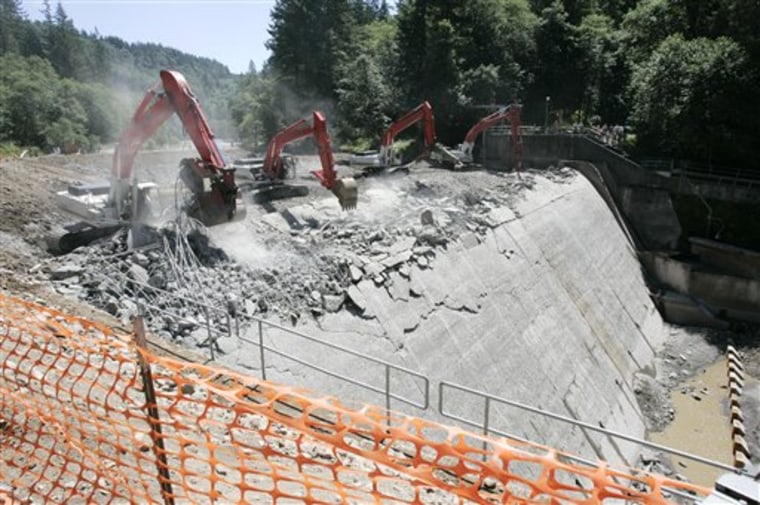The largest dam removal in the Pacific Northwest in 40 years is under way, with 4,000 pounds of explosives used Tuesday to blast the top level of one structure into oblivion.
When the two dams are fully removed, one this summer and the other next summer, the Sandy River will be a free-flowing river for the first time in nearly a century — and no longer a hindrance to steelhead and salmon returning to spawn.
Eight feet of the 47-foot-tall Marmot Dam was removed Tuesday and over the next two months there will be five more blasts, along with jackhammers working daily, according to the dams' owner, Portland General Electric.
Portland General Electric, the biggest utility in Oregon, is spending $17 million to remove the two dams in coordination with 23 environmental, governmental and civic organizations.
"Today, this partnership took a great step toward restoring a breathtaking river for fish, wildlife and people," Portland General Electric CEO and President Peggy Fowler said in a statement. "We celebrate the future of a watershed that will provide unimpeded salmon and steelhead passage from the slopes of Mt. Hood to the Pacific Ocean." (General Electric is the parent company of NBC, which is a partner in the joint venture that operates MSNBC.com.)
"It's incredibly significant for the entire Sandy River Basin; it's going to breath new life into the basin and it's going to provide new recreational and fishing opportunities," added Amy Kober, a spokeswoman for American Rivers, a conservation group. "This was a region that was built by dams, but we are realizing the benefits of healthy rivers. We are getting back into balance."
Free run to Columbia River
The Marmot Dam, located on the Sandy River about 40 miles east of Portland, was built almost 100 years ago along with the nearby 16-foot-high Little Sandy Dam, which will be destroyed next summer, the utility said.
Removing the two dams will allow the Sandy to flow freely from Mt. Hood to the Columbia River.
When the dams were built, they ruined a natural fish run that biologists say the fish will rediscover and repopulate once the dams are removed.
The river is home to winter steelhead, spring Chinook and coho salmon, all listed on the federal Endangered Species Act.
"Steelhead and salmon need free-flowing rivers to survive," said Mike Myrick, a member of the Sandy River Chapter of Northwest Steelheaders. "Removal of Marmot Dam is a historic moment in salmon recovery taking place in the backyard of metropolitan Portland."
The dam removal will take away 22 megawatts of power generation capacity from Portland General, leaving it with hydro capacity of 487 megawatts.
The Marmot Dam has a fish ladder but once the dam is destroyed, the fish will be able to pass without a ladder made by humans.
Though removing the dams will likely revive fish stocks over the next decade, there are risks. Silt has backed up behind the Marmot dam over the past century and biologists fear a harsh winter storm could wash nearly all the sediment — estimated to be nearly 1 million cubic yards of sand and gravel — down the river over several days.
This could suffocate salmon eggs which need a constant stream of oxygenated water to survive. If the region experiences mild winters, the sediment could wash out to the Pacific Ocean over the next several years.
Todd Alsbury, a biologist with the Department of Fish and Wildlife, said as a precaution his agency would keep 20 pair of fall Chinook in a hatchery where they will produce close to 100,000 fish. Those fish will be released next spring when the salmon begin migrating to the Pacific Ocean.
Other removal, restoration work
When the Marmot is fully dismantled later this summer, it will have been the tallest dam to be removed in the Northwest in 40 years — and the largest ever removed in Oregon.
The dam removal kicks off a wave of river restoration projects and dam removals in the Northwest. Kober said many dams have reached the end of their life span and with stricter environmental legislation utilities are finding it more difficult to keep them economically viable.
The Savage Rapids Dam along the Rogue River; the Condit Dam on the White River in Washington; two dams along the Elwha River in Washington — including what will be the nation's tallest dam to be decommissioned at 210-feet — are all scheduled to be taken down over the next several years.
"Nationally, dam removal is an accepted mainstream thing these days," Kober said. "We are moving more and more outdated dams and communities are embracing this to get their rivers back."
PGE officials said the 22 megawatt capacity dam system, built in 1913, was too costly to maintain, particularly considering new environmental protections for endangered salmon and steelhead. The utility is building a 126 megawatt wind farm in southern Oregon that is expected to go online by December.
"When we made this decision in 1999 we did an analysis of how much it would take to keep the dams in and upgrade them to modern fish protection," said Mark Fryburg, a PGE spokesman. "The maintenance costs are rather high."
